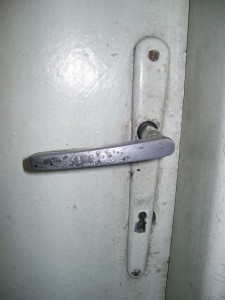
Saw this paper by Ashley Rose and Josh Neufeld, “Microbial biogeography of a university campus” and just had to check it out. Basically the authors conduced a survey of door handles across 65 buildings and three time points on the Waterloo campus. What I think it most interesting about their results is the finding that some buildings showed a consistent microbial signature, as distinct from other buildings. I would have guessed that the vast majority of the signal would be from transient deposition by people touching the doorknobs.
I also love the understated humor, for example “Exacerbating the numerous colds and flus that are transmitted in dormitories and lecture halls, some university students may not be diligent hand washers”. You think?
Abstract below:
Background
Microorganisms are distributed on surfaces within homes, workplaces, and schools, with the potential to impact human health and disease. University campuses represent a unique opportunity to explore the distribution of microorganisms within built environments because of high human population densities, throughput, and variable building usage. For example, the main campus of the University of Waterloo spans four square kilometres, hosts over 40,000 individuals daily, and is comprised of a variety of buildings, including lecture halls, gyms, restaurants, residences, and a daycare.
Results
Representative left and right entrance door handles from each of the 65 buildings at the University of Waterloo were swabbed at three time points during an academic term in order to determine if microbial community assemblages coincided with building usage and whether these communities are stable temporally. Across all door handles, the dominant phyla were Proteobacteria, Firmicutes, Actinobacteria, and Bacteroidetes, which comprised 89.0 % of all reads. A total of 713 genera were observed, 16 of which constituted a minimum of 1 % of the 2,458,094 classified and rarefied reads. Archaea were found in low abundance (~0.03 %) but were present on 42.8 % of the door handles on 96 % of buildings across all time points, indicating that they are ubiquitous at very low levels on door handle surfaces. Although inter-handle variability was high, several individual building entrances harbored distinct microbial communities that were consistent over time. The presence of visible environmental debris on a subset of handles was associated with distinct microbial communities (beta diversity), increased richness (alpha diversity), and higher biomass (adenosine 5′-triphosphate; ATP).
Conclusions
This study demonstrates highly variable microbial communities associated with frequently contacted door handles on a university campus. Nonetheless, the data also revealed several building-specific and temporally stable bacterial and archaeal community patterns, with a potential impact of accumulated debris, a possible result of low human throughput, on detected microbial communities.

Here is the link to the paper in Microbiome:
http://microbiomejournal.biomedcentral.com/articles/10.1186/s40168-015-0135-0
Whoops! Added a link above. Thanks Elisabeth…